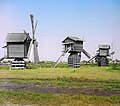Codend (windmill)
The codend ( Low German for tail or tail), also called stert , sterz or Vordrehbaum , is a long bar for aligning the blades of windmills against the wind ("Krüllen"). Until the invention and introduction of the wind rose, it was the predominant system for tracking the wind direction .
Since the blades of a windmill should be at right angles to the prevailing wind direction for efficient operation , the cap (to which the wing cross is attached) in Dutch windmills and even the entire mill case in post windmills are rotatable. To turn this into the desired position, use the codend attached to the back of the cap or the mill box. It is a long cantilever beam that extends to the ground or gallery windmills reaching down to the gallery. This beam is often the central part of a beam construction in which four (sometimes only two) additional beams, called "swords" or "scissors", stabilize it in a V-shape on both sides; the swords are attached to two (or one) cross pieces of wood attached to the cap, the "Spreet beams".
The codend can either be turned by muscle power without special aids - or it is provided at its lower end with a rotary winch or an adjusting wheel, the so-called jogger reel , through which one or two chains are turned, the loose ends of which are attached to the gallery or are attached to the piles on the ground around the mill, and with this the wings are turned into the wind (krühp, kröjt, ndl. kruit).
Tower windmill “de la Falaise”, Batz-sur-Mer, Bretagne , with clearly visible codend
Post mill from Essern in the museum village of Cloppenburgm with clearly visible codend
Footnotes
- ^ Berthold Moog et al .: Dictionary of Molinology . English - German - French - Dutch. Ed .: The International Molinological Society . Watford 2004 ( full text on molinology.org [PDF] Original title: Dictionary of Molinology . Draft).
- ↑ The English term is tail pole.
- ↑ Low German Kroyhaspel or Kröjhaspel, from Dutch Kruihaspel, also called Krühwerk.









